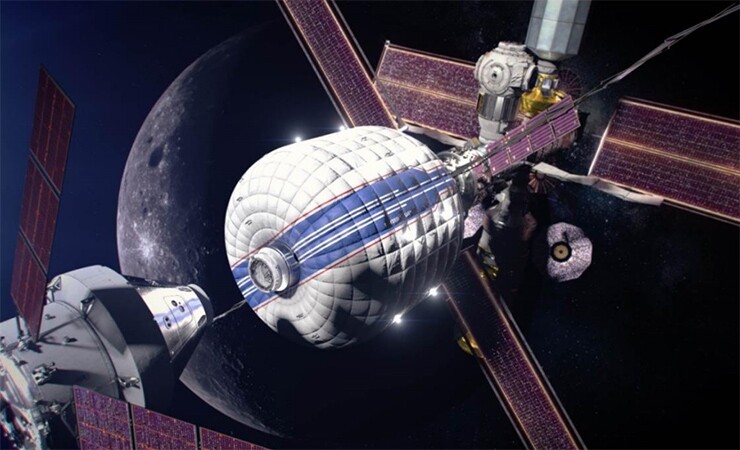
A conceptual illustration of the proposed Gateway lunar outpost after it has been built out.
(Image credit – NASA)

A conceptual illustration of the proposed Gateway lunar outpost after it has been built out.
(Image credit – NASA)
NASA released an outline
Though their details remain to be worked out, these long-term plans are exerting a strong pull on NASA’s burgeoning lunar science program. Right now, the agency has four robotic surface missions actively in the works, including a small lander and a rover that are both bound for the lunar south pole, the same region as its planned first crewed landing. NASA is focusing on the polar region in part because water ice there could be used for life support and to manufacture propellant. NASA believes the successful exploitation of such lunar resources will help motivate more intensive surface exploration, including by commercial entities.
Before its first crewed landing, targeted for 2024, NASA expects its robotic landers will begin launching as soon as 2021 and continue at a cadence of about two per year through the foreseeable future. To ensure the work they undertake is well orchestrated, the agency has now set up a new program called PRISM (Payloads and Research Investigations on the Surface of the Moon) that aims to coordinate the selection of payloads, lander vehicles, and landing sites for missions launching in 2023 and beyond.
According to NASA’s plans, the centerpiece of its lunar activities following the first crewed landing will be a permanent facility near the south pole called Artemis Base Camp. The camp would be built up over time to include a stationary habitat, vehicles enabling long-distance work, and infrastructure such as power generators and equipment for lunar resource utilization.
The principal aim of surface activities would be to demonstrate capabilities and technologies
In lunar orbit, the proposed crewed outpost known as the Gateway remains a central component of NASA’s long-term plans, though the agency has moved away
NASA is emphasizing opportunities the Gateway presents for research outside the Van Allen radiation belts, which shield the Earth from cosmic rays and charged particles emanating from the Sun. Such radiation presents a hazard for astronauts working in deep space and on the lunar surface. Accordingly, in March NASA selected
More generally, all of NASA’s long-term plans remain steeped in uncertainties, including political ones. Even on its own, the first crewed landing is expected to require many billions of dollars in additional funding, and Congress has only provided a part of what NASA said it needed for the program’s first and least expensive year. NASA’s ambitious plan for the period following the landing would require still more funding, and the agency acknowledges that international and commercial partners will need to carry a significant share of the burden.
To further encourage commercial activity, President Trump issued an executive order
Although commercial endeavors on the lunar surface remain a distant prospect, NASA is priming the pump for them through its Commercial Lunar Payload Services (CLPS) program.
CLPS issues task orders for companies to convey science and technology payloads to the lunar surface using landers they design, build, and operate. NASA has already issued two task orders for the landers that are scheduled for launch in the fall of 2021. However, Steve Clarke, the NASA official who heads the CLPS program, said on March 31
Meanwhile, NASA is already looking ahead to future CLPS missions. On April 8, the agency announced
NASA is building VIPER itself and plans to deliver it through the CLPS program. Clarke said NASA expects to issue a task order for the mission in late May or early June. VIPER’s launch was originally planned for late 2022, though that date has since slipped to mid-to-late 2023. NASA has stated

An engineering model of VIPER being tested at NASA’s Glenn Research Center.
(Image credit – Bridget Caswell, Alcyon Technical Services / NASA)
According to Clarke, NASA plans to request proposals this summer for a fifth CLPS task order, a lander mission to a non-polar destination that will take place sometime in early 2023, with payloads selected from proposals already submitted for inclusion on earlier landers. However, for missions further down the road, he said the payloads would be drawn from proposals submitted through the new PRISM program.
On April 10, NASA opened
The database will inform NASA’s selection of destinations across the Moon for future CLPS landers. To select specific payloads for the landers, NASA plans to draw from proposals responding to a series of “Stage-2” PRISM calls, the first of which is set to be issued this summer. According to Clarke, NASA will prioritize proposals for suites of instruments tailored to specific destinations, though proposals for “high-value location-agnostic” instruments will also be welcomed.
So far, Congress has provided NASA’s lunar science program with all the funding requested for it, ramping its budget up from $22 million in fiscal year 2018 to about $300 million this year. Seeking $452 million for fiscal year 2021, NASA specifies that $254 million is for the CLPS program, $38 million is for instrument projects, $68 million is for VIPER, and $70 million is to support early work on future missions.
NASA anticipates its funding requirements for instrumentation projects will increase to $71 million beginning in fiscal year 2022. However, unlike its projections for crewed lunar exploration, NASA expects its overall budget needs for lunar science to remain roughly steady in the years ahead, hovering in the vicinity of $500 million.